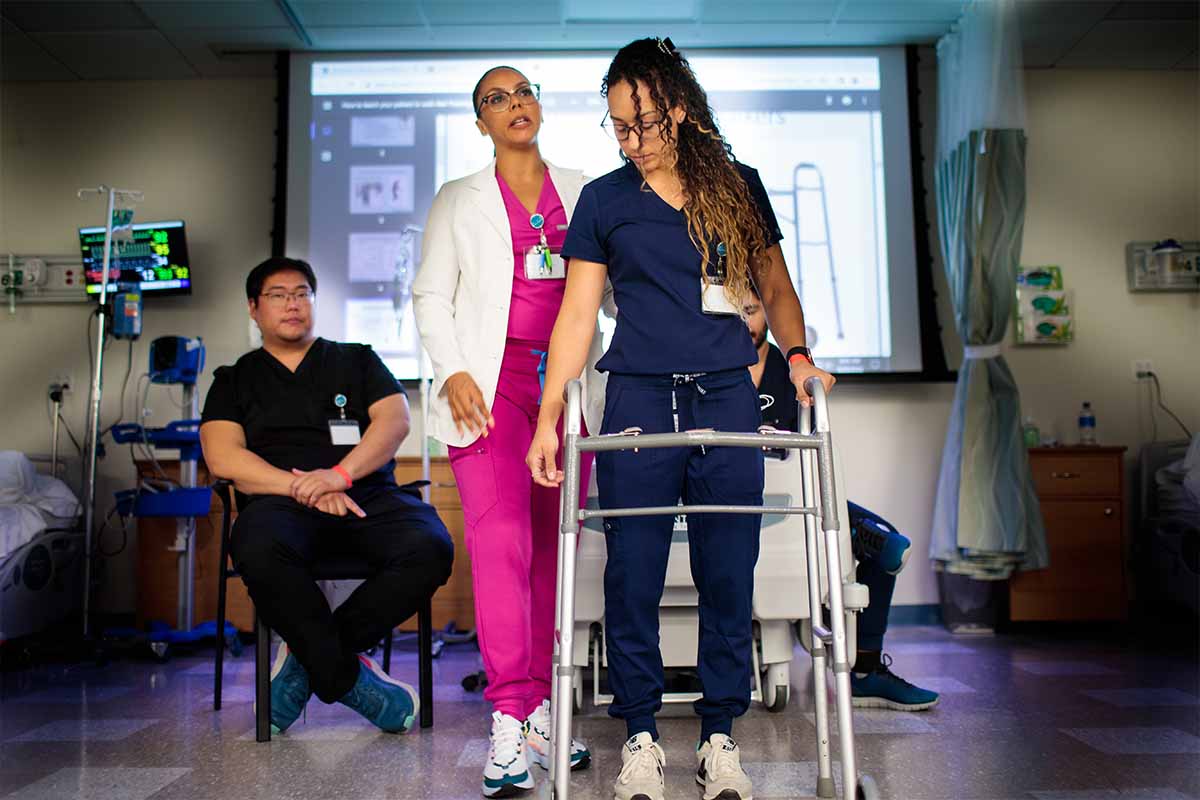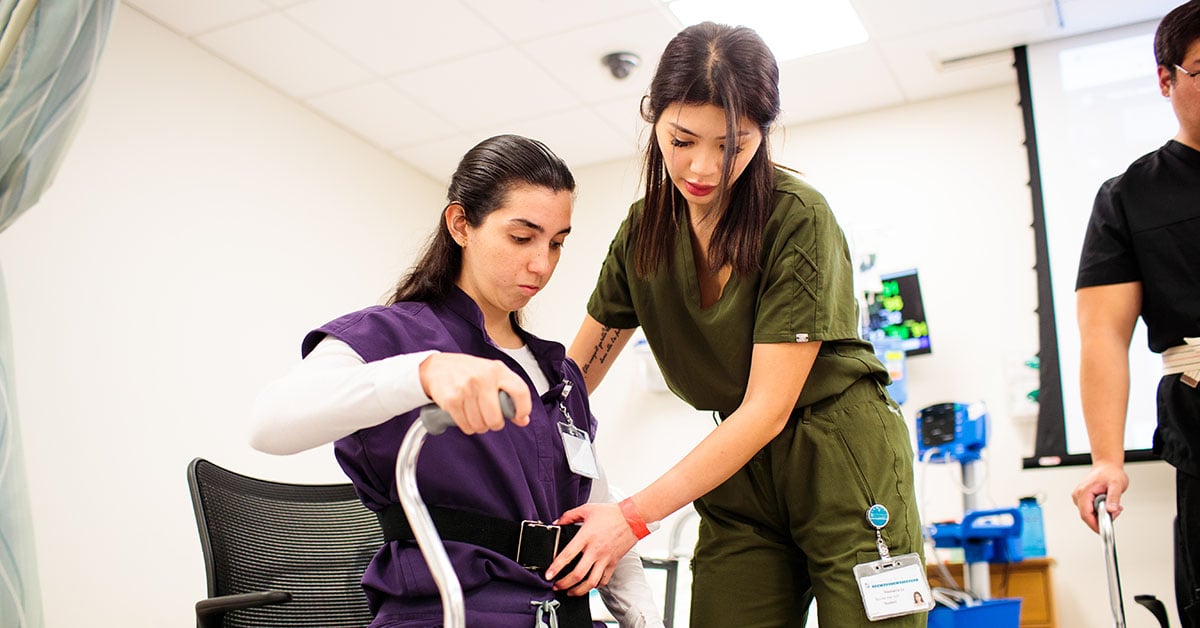

An occupational therapist’s career can be rewarding as it involves helping individuals perform meaningful everyday activities.1 Not only is occupational therapy a rewarding career, but it also offers a promising salary. As of May 2022, the U.S. employed almost 135,000 occupational therapists who earned an average annual salary of $92,800.2
In this post, we walk you through what it takes to get an occupational therapy degree, how long it takes, specialty opportunities and more. With these steps, you’ll know what it takes to launch your career as an exceptional occupational therapist.
Table of Contents:
- What Is Occupational Therapy?
- What Do Occupational Therapists Do?
- What Skills Do You Need to Be an Occupational Therapist?
- What Are the Benefits of Becoming an Occupational Therapist?
- What Are Occupational Therapy Job Opportunities?
- How Much Do Occupational Therapists Make?
- Occupational Therapist Specialty Opportunities
- Five Steps to Become an Occupational Therapist
- How USAHS Can Help You Prepare to Be an Exceptional Occupational Therapist
What Is Occupational Therapy?
Occupational therapists (OTs) use their skills to assist patients with different cognitive or physical conditions that limit their capacity to perform day-to-day activities.1 As an OT, you help patients participate in important activities, or “occupations,” of daily life.1
OTs apply their ingenuity to find customized adaptive movements and technologies that help patients participate more fully in occupations like work, play, leisure, education and social interaction. OTs also work with patients on Activities of Daily Living (ADLs), such as eating, bathing and getting dressed.1
What Do Occupational Therapists Do?
Occupational therapists work with people of all ages and who may have different cognitive and physical capabilities.1 An occupational therapist begins their work by communicating with the patient, teachers, family or caregivers to better understand the patient’s needs.1
Next, the occupational therapist assesses the patient’s physical, sensory, emotional and cognitive capacities to develop goals and a treatment plan. From here, the patient and the OT work together to develop and improve skills. While working toward the stated goals, the patient and OT regularly evaluate the patient’s progress.1
The responsibilities of occupational therapy practitioners may include1:
- Helping patients learn new ways to perform ADLs
- Supporting patients in creating a daily routine, learning memory tricks and problem-solving
- Teaching patients how to use adaptive equipment
- Working with patients who have developmental and cognitive conditions
- Teaching patients how to prevent falls and make the home safer and more accessible
- Helping patients return to school, work and other activities
- Training family and caregivers
One of the prime differences between physical therapy versus occupational therapy is that OTs help patients gain or regain the ability to perform daily activities independently, and physical therapists help patients improve their ability to move and manage pain.
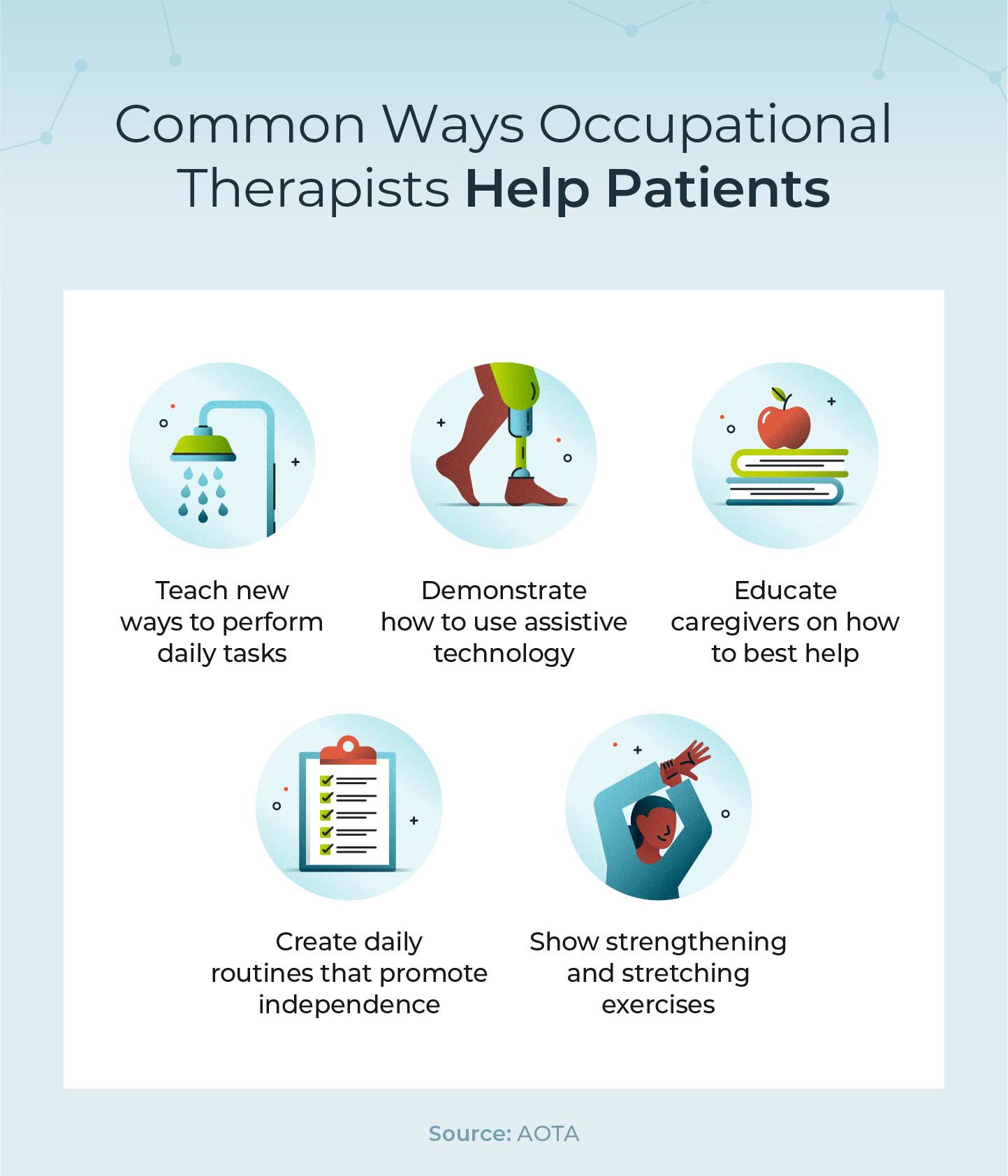

What Skills Do You Need to Be an Occupational Therapist?
A leading school for occupational therapy will teach you how to do a hands-on assessment and train you with the skills to perform treatment. OTs have strong communication skills and know how to work effectively in teams. They are creative problem-solvers and design customized solutions for clients. They have empathy for their clients and display flexibility and patience.
As an occupational therapist, you will work with people who have cognitive and physical challenges. While this can sometimes be stressful, it’s important to practice patience, compassion and kindness to help your patients reach their goals.
What Are the Benefits of Becoming an Occupational Therapist?
Occupational therapy is a field that continues to grow, with a projected 9,600 job openings per year.3 Many employers offer flexible part-time or PRN (as needed) work. Working as an OT is also rewarding because you help people improve their quality of life. Once you earn an occupational therapy degree, you can build your creative niche within the field or open a private practice.
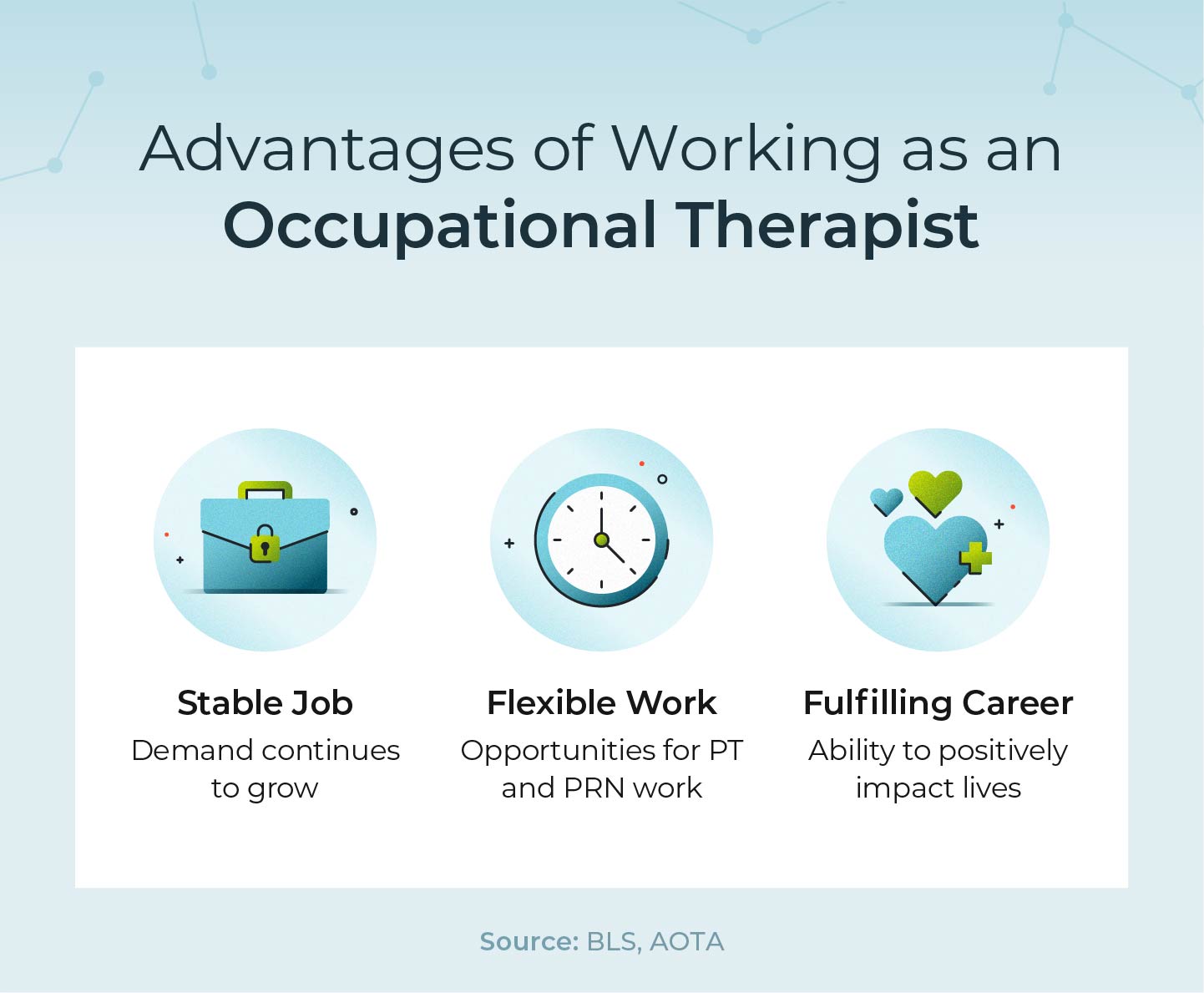

What Are Occupational Therapy Job Opportunities?
The job market for OTs has a projected growth of 9% by 2032, which is much faster than other industries.4 In addition to growing job opportunities, occupational therapists are able to work in various settings.
The most recent data shows that most OTs work in state, local and private hospital settings.5 After hospital settings, the most common workplaces for OTs are the offices of audiologists and physical, occupational and speech therapists.5
| Work Environment | Percentage5 |
|---|---|
| Hospitals; state, local and private | 29% |
| Offices of physical, occupational and speech therapists and audiologists | 28% |
| Elementary and secondary schools; state, local and private | 12% |
| Home healthcare services | 8% |
| Nursing care facilities (skilled nursing facilities) | 7% |
The profession of an occupational therapist was also ranked #4 in U.S. News & World Report’s 2024 Best Health Care Jobs list.
How Much Do Occupational Therapists Make?
The mean annual pay for occupational therapists in the United States is $92,800 per year, and those in the 90th percentile of earners make upward of $123,870 per year.1 How much you make as an OT may vary based on your industry.


For example, pediatric occupational therapists at elementary schools make an average salary of $83,070, while those in home healthcare services make an average of $105,700.1
When becoming an occupational therapist, you may want to consider relocating. Some states pay more than others, but it’s also helpful to consider the cost of living. Here are the average annual wages for each state:
| State | Annual Mean Wage 1 |
|---|---|
| Alabama | $86,860 |
| Alaska | $100,810 |
| Arizona | $90,740 |
| Arkansas | $82,920 |
| California | $109,220 |
| Colorado | $97,720 |
| Connecticut | $95,400 |
| Delaware | $88,180 |
| Florida | $88,910 |
| Georgia | $95,060 |
| Hawaii | $96,600 |
| Idaho | $84,640 |
| Illinois | $89,330 |
| Indiana | $87,510 |
| Iowa | $83,820 |
| Kansas | $87,030 |
| Kentucky | $83,960 |
| Louisiana | $91,790 |
| Maine | $76,490 |
| Maryland | $95,810 |
| Massachusetts | $91,840 |
| Michigan | $83,900 |
| Minnesota | $81,840 |
| Mississippi | $89,590 |
| Missouri | $85,780 |
| Montana | $84,680 |
| Nebraska | $87,620 |
| Nevada | $105,020 |
| New Hampshire | $83,930 |
| New Jersey | $104,710 |
| New Mexico | $94,100 |
| New York | $95,280 |
| North Carolina | $86,270 |
| North Dakota | $78,020 |
| Ohio | $91,670 |
| Oklahoma | $90,200 |
| Oregon | $96,370 |
| Pennsylvania | $88,560 |
| Rhode Island | $92,110 |
| South Carolina | $88,090 |
| South Dakota | $76,900 |
| Tennessee | $91,040 |
| Texas | $96,900 |
| Utah | $89,740 |
| Vermont | $81,710 |
| Virginia | $97,980 |
| Washington | $94,450 |
| Washington D.C. | $96,000 |
| West Virginia | $78,410 |
| Wisconsin | $82,080 |
| Wyoming | $84,650 |
Occupational Therapist Specialty Opportunities
As you learn how to become an occupational therapist, you may consider working toward certification in a specialty area. Popular occupational therapy specialties include physical rehabilitation, driving and community mobility, gerontology, pediatrics and mental health. Keep in mind that most specialties require significant job experience (the American Occupational Therapy Association [AOTA] proposes 3,000 hours) in the certification area.6
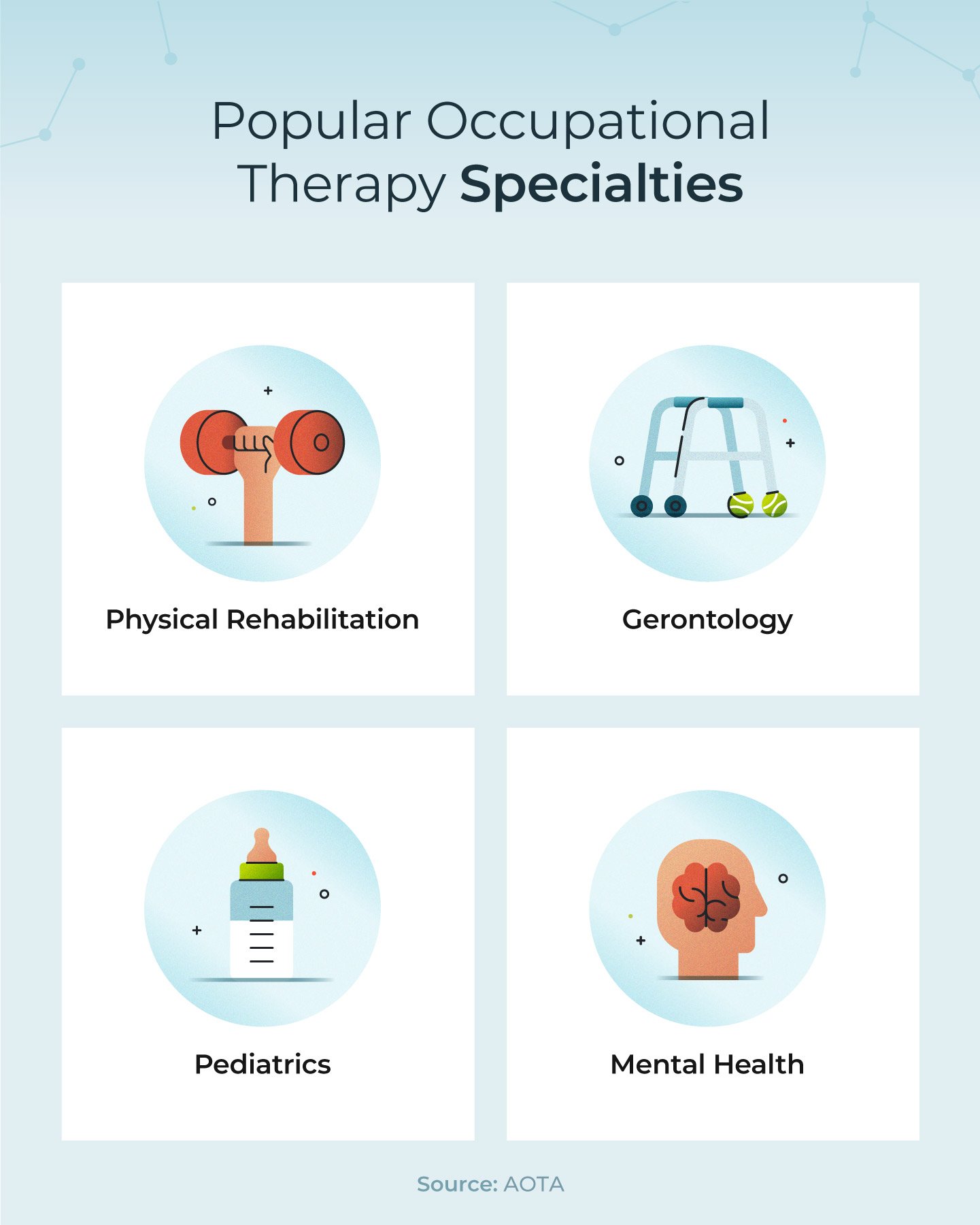

5 Steps to Become an Occupational Therapist
If this career sounds like a good fit, learn how to earn an occupational therapy degree. You wonder, “How long does it take to become an occupational therapist?” To become a licensed occupational therapist, you will need to earn a graduate degree and will be required to pass certification exams.7
While in school as an occupational therapy student (OTS), you will have fieldwork assignments and required supervised work.8 Each state has different licensure requirements, so determine what you need to do for the state where you’ll be working.8


1. Earn a Bachelor’s Degree
The first step is to earn a bachelor’s degree in a relevant area, such as biology, health science or psychology. If you wish to become an occupational therapy assistant (OTA) rather than an OT, you only need an associate degree in OT. For those seeking an MOT degree, USAHS offers an OTA to OT Bridge program.
2. Complete Prerequisites
As mentioned, to pursue a graduate degree, there are prerequisites. To apply for USAHS, do a prerequisite check to find the specific courses needed before applying to our graduate programs. You can also find prerequisite details in our MOT and OTD admission pages.
The prerequisites for our MOT and OTD programs include the following:
| Course | Semester Hours | Quarter Hours |
|---|---|---|
| Anatomy and Physiology with Lab, Human Anatomy and Physiology I & II, General Human Anatomy, General Human Physiology | 8 | 12 |
| Sociology or Anthropology, Sociology, Anthropology, Sociocultural Anthropology, Biological Anthropology | 3 | 4.5 |
| Human Growth and Development (Lifespan) | 3 | 4.5 |
| Abnormal Psychology | 3 | 4.5 |
| Statistics | 3 | 4.5 |
| Medical Terminology | This is a hybrid program requiring both virtual (distance education) and face-to-face class participation. Online learners need access to/use of a computer/word processor and basic technical skills to succeed. These skills include the ability to create new documents, use a word processing program, navigate the Internet, and download software. Attendance requirements are enforced. | This is a hybrid program requiring both virtual (distance education) and face-to-face class participation. Online learners need access to/use of a computer/word processor and basic technical skills to succeed. These skills include the ability to create new documents, use a word processing program, navigate the Internet, and download software. Attendance requirements are enforced. |
3. Choose a Graduate Program
Once you have completed the prerequisites, it’s time to choose a graduate degree program. Pursue a Master of Occupational Therapy (MOT) or Doctor of Occupational Therapy (OTD) program. In addition to the required coursework, the curriculum for both programs will include the fieldwork hours you need to sit for the certification exam. USAHS now offers an OTA to MOT bridge program so you can earn your MOT in as little as two years.Time to completion may vary by student, depending on individual progress, credits transferred and other factors.
There are different career opportunities for each path. With your MOT, you can become a clinician and work with people of all ages to help them improve their quality of life by overcoming cognitive and physical challenges. With an OTD, you can collaborate with mentors and peers, explore additional areas of occupational therapy and enhance your critical skills.
USAHS also offers a Post-Professional Doctor of Occupational Therapy (PPOTD). This degree is for practicing OTs with either a bachelor’s or master’s degree in occupational therapy who are looking to expand their knowledge and credentials. The PPOTD offers advanced studies in research skills, practice skills, administration, leadership, program development and education.
To prepare for a graduate program interview, check out our post on occupational therapy interview questions.
4. Become Certified
After completing either an MOT or OTD, you must pass the National Board for Certification in Occupational Therapy (NBCOT) exam to be licensed to practice in the United States.
5. Obtain State Licensure
Once you pass the NBCOT, you will need to get licensed in the state where you choose to practice. State licensing requirements may vary, so it’s important to consult your state’s occupational therapy regulatory agency.
How USAHS Can Help You Prepare to Be an Exceptional Occupational Therapist
If you’re looking for schooling to become an occupational therapist, USAHS has a range of options for you to choose from. We offer MOT and OTD programs, and we also have a new OTA to MOT pathway. Additionally, we offer a PPOTD program.
At USAHS, study alongside expert faculty-practitioners and benefit from state-of-the-art simulation centers where you can leverage our high-tech tools and practice with mock patients. Once you graduate, you’ll join the largest community of practicing OT alumni.Based on total MOT degrees conferred as reported by the Integrated Postsecondary Education Data System (IPEDS) Data is captured through interrelated surveys conducted annually by the Department of Education’s National Center for Educational Statistics (NCES), and from USAHS’ internal graduation data. To get started, apply today.
Sources:
- American Occupational Therapy Association, “What is occupational therapy?” American Occupational Therapy Association, https://www.aota.org/about/what-is-ot.
- U.S. Bureau of Labor Statistics, “Occupational Employment and Wage Statistics,” U.S. Bureau of Labor Statistics, last modified May 2022, https://www.bls.gov/oes/current/oes291122.htm.
- U.S. Bureau of Labor Statistics, “Occupational Outlook Handbook,” U.S. Bureau of Labor Statistics, last modified May 2022, https://www.bls.gov/ooh/healthcare/occupational-therapists.htm#tab-6.
- O*Net OnLine, “Occupational Therapists,” O*Net OnLine, https://www.onetonline.org/link/summary/29-1122.00.
- U.S. Bureau of Labor Statistics, “Occupational Outlook Handbook,” U.S. Bureau of Labor Statistics, last modified May 2022, https://www.bls.gov/ooh/healthcare/occupational-therapists.htm#tab-3.
- American Occupational Therapy Association, “Board Certification in Physical Rehabilitation,” American Occupational Therapy Association, https://www.aota.org/career/advanced-certification-program/physical-rehabilitation.
- U.S. Bureau of Labor Statistics, “Occupational Outlook Handbook,” U.S. Bureau of Labor Statistics, last modified May 2022, https://www.bls.gov/ooh/healthcare/occupational-therapists.htm#tab-4.
- Sarah Lyon, OTR/L, “How to Become an Occupational Therapist (2023),” OT Potential, last modified August 2023, https://otpotential.com/blog/become-an-occupational-therapist.







